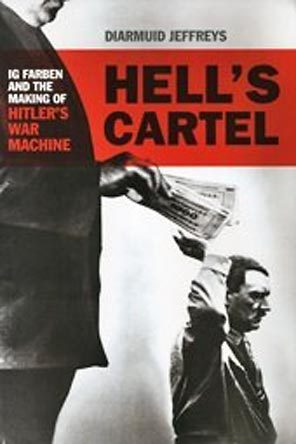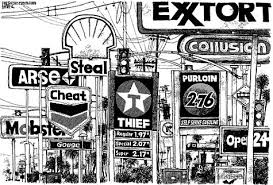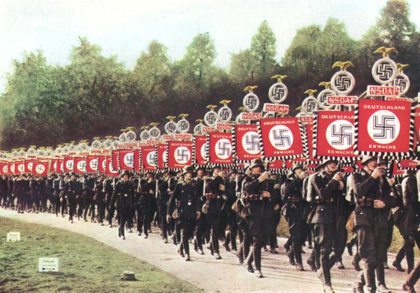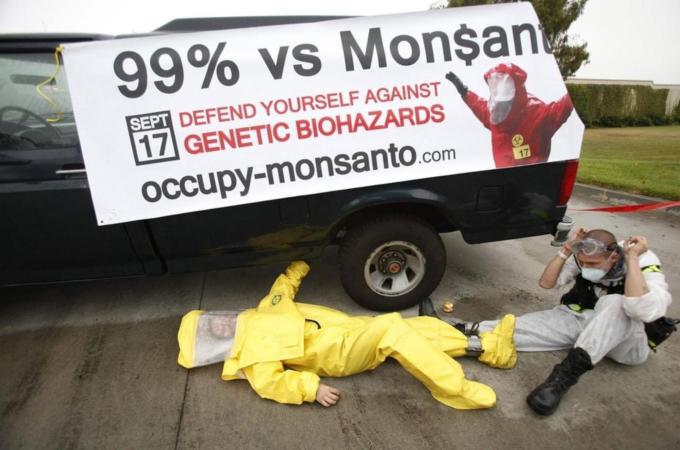Alex Constantine - December 27, 2013
" ... Drawing on extensive investigative research and original interviews, Hell’s Cartel not only sheds new light on the co-dependence of industry and the Third Reich, but also offers a timely warning against the dangerous merger of politics and the pursuit of profit. ... "
Shahriar Feroze stumbles into unpalatable truths
Rather than being a narrative dealing with historical facts and stories spinning out of military campaigns, this is a book that comes with a different perspective encircling the Third Reich and The Second World War along with the rise of a chemical conglomerate by the name of IG Farben. Diarmuid Jeffrey’s Hell’s Cartel investigates how the fourth largest industrial concern during the tumultuous 1930s empowered the Nazi war machine with deadly chemicals, innovative technologies and sinister scientific experiments. At its peak in the 1930s, IG Farben (its full name translates as Community of Interests of Dye-Making Companies) was one of the most powerful corporations in the world, big enough to be labelled as the Microsoft of the 1930s.
The book, beginning with a courtroom scene taking place at Nuremberg, follows the first comprehensive account of IG Farben’s rise and fall, tracing the enterprise from its nineteenth-century origins, when the discovery of synthetic dyes gave rise to a vibrant new industry through the upheavals of the Great War era, and on to the company’s fateful role in World War II. Fascinatingly, To this day, companies formerly part of the IG Farben cartel—the aspirin-maker Bayer, the graphics supplier Agfa, the plastics giant BASF—continue to play key roles in the global market. IG Farben itself, however, is remembered mostly for its infamous connections to the Nazis and its complicity in the atrocities of the Holocaust. After the war, Farben’s leaders were tried for crimes that included mass murder and exploitation of slave labour.
It is the not-very-often-talked-about characters that appear as the protagonists in the book. They are businessmen, scientists, inventors, plant managers, planners to suppliers to many more of a conglomerate that directly contributed to building an ill-omened war machine that would end in the extermination of millions of men and women while establishing a barbaric short-lived empire. Labelled as Hell’s cartel, IG used slave labour to operate a synthetic fuel plant at Auschwitz and made an estimated 10,000 kilos of ‘Zyklon-B’ for the gas chambers. Moreover, the chemical agent ‘Sarin’ used in Syria a couple of months ago was also invented during the 1930s by some of the IG scientists.
 It is IG Farben’s direct involvement in materializing the phases of the ‘final solution’ that is usually remembered with hate and disgust. Aside from the menacing part of Farben’s role there is a brilliant narrative about German chemists, scientists, pharmacists and companies reigning supreme in the global chemical and pharmaceutical markets for well over six decades, followed by brief anecdotes of inventions and discoveries appearing sporadically through the first five chapters. Chapters 6-11 are about the ‘Faustian pact’ between the conglomerate and the Third Reich.
It is IG Farben’s direct involvement in materializing the phases of the ‘final solution’ that is usually remembered with hate and disgust. Aside from the menacing part of Farben’s role there is a brilliant narrative about German chemists, scientists, pharmacists and companies reigning supreme in the global chemical and pharmaceutical markets for well over six decades, followed by brief anecdotes of inventions and discoveries appearing sporadically through the first five chapters. Chapters 6-11 are about the ‘Faustian pact’ between the conglomerate and the Third Reich.
After the Nuremberg trials, the manufacturers of several poisonous chemicals claimed ignorance and were released, and this was the sad part one comes across as one reads through the work. In spite of their engaging in such criminal acts, the verdicts turned out to be comparatively lighter sentences. Justice was surely denied. Another factor worth mentioning about the IG tribunal, formed largely by US lawmakers, is the complications related to the preparation of the IG case in war torn Germany. Much of the substantive evidence required to form a strong case was destroyed deliberately by the culprits. Here the reviewer comes to learn about the technical difficulties considering the legal aspects of a case (based on the charges of crime against humanity) that was conducted by inexperienced judges. There are some valuable lessons for our lawyers linked to the ongoing International Criminal Tribunal (ICT).
However, the cartel was broken up some five years later after WW2 had ended and its constituent companies, including Bayer, Hoechst, BASF and Agfa, resumed business. Drawing on extensive investigative research and original interviews, Hell’s Cartel not only sheds new light on the co-dependence of industry and the Third Reich, but also offers a timely warning against the dangerous merger of politics and the pursuit of profit. For the history-hungry bookworm it is a thrilling read. Though the photo used in the cover page does not match the name and the contents of the book, there are some exciting black and white photos inside.
Unfortunately, the book is not an easy get. The paperback could be ordered at a little less than US$18, including shipping charges through Amazon.com or through www. Bloomsbury.com (the original publisher of the book, with a different price).
http://archive.thedailystar.net/beta2/news/remarkable-rise-and-scandalous-fall/









